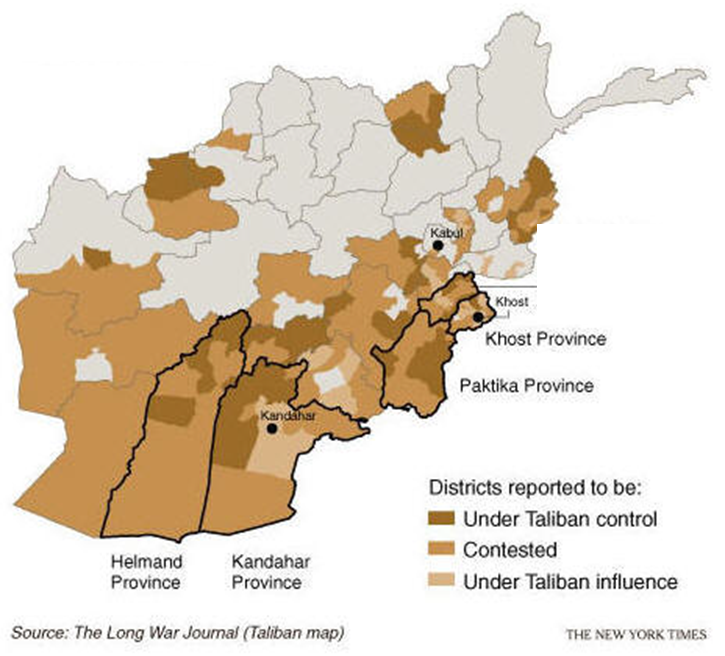
Why Are We in
Afghanistan?
Journey to the Center of the Future
The
Taliban
is sitting atop one of the world's few known concentrations
of
Rare Earth Minerals
- in the case of the small village of Khan Neshin (below),
cerium and
neodymium - and that gives
these backwards Islamic fundamentalists a big say in the
future of the world's technological development. Weird,
right? It may also help explain why the U.S. is in
Afghanistan years after our mission there to deny Al Qaeda
the support of the Taliban, and even our search for Osama
Bin Laden, has ended.
 |
Why Are We in
Afghanistan?
Journey to the Center of the Future
The
Taliban
is sitting atop one of the world's few known concentrations
of
Rare Earth Minerals
- in the case of the small village of Khan Neshin (below),
cerium and
neodymium - and that gives
these backwards Islamic fundamentalists a big say in the
future of the world's technological development. Weird,
right? It may also help explain why the U.S. is in
Afghanistan years after our mission there to deny Al Qaeda
the support of the Taliban, and even our search for Osama
Bin Laden, has ended.

By RAR
The
Moon colony in the Google satellite image above is
Khan Neshin, Afghanistan,
in the Helmand Province
(southern part of the country). This has been the tough nut
to crack for the U.S. military, for the area remains largely
controlled by Taliban.
 For
reference, see this "Map of Taliban Control", published by
the New York Times in December 2009, when the U.S. surged an
additional 30,000 troops into the Kabul area. For
reference, see this "Map of Taliban Control", published by
the New York Times in December 2009, when the U.S. surged an
additional 30,000 troops into the Kabul area.
While the U.S. and its allies
have had little success in 10 years in terms of ridding the
country of Taliban influence - there have been ongoing talks
all along to determine how the Taliban could be brought into
a normalized Afghanistan government - there have been
militarily-secured campaigns by the
U.S. Geological Survey to
map the region around Khan Neshin, which Russian scientists
have reported being a location of recoverable
Rare Earth Minerals. The
USGS study team has located a sizable area of rocks in the
center of an extinct volcano containing light rare earth
elements including cerium and neodymium. It has mapped 1.3
million metric tons of desirable rock, or about 10 years of
supply at current demand levels. The Pentagon has estimated
its value at about $7.4 billion. (Simpson, S.: Afghanistan's
Buried Riches, "Scientific American", October 2011).
Rare Earth Minerals are the
doorway to the future, in terms of developing a growing list
of technological developments: super-strength metals that
can survive high heat conditions, useful for space travel,
but presently used in baseball bats, lacrosse sticks,
bicycle frames, revolvers, and light bulb elements; LED
displays and cancer treatments; batteries, electronic vacuum
tubes, camera and telescope lenses, medications; catalytic
converters in automobiles; carbon-arc lighting (motion
picture industry); aircraft engines, coloring of cubic
zirconias and other glass, cigarette lighters and other
handheld fire-starters; the strongest magnets currently
developed; nuclear batteries and beta radiation sources;
lasers; screening for genetic diseases, anti-counterfeiting
phosphors in bills; shielding for nuclear reactors; color
television tubes, fuel cells, naval sonar systems and
certain alloys; laser materials, neutron-absorbing control
rods in nuclear reactors, hard disks, absorption rods in
nuclear reactors, high intensity lighting; optical
amplifiers, fiber optic cables, medical and dental lasers;
portable x-ray devices and high temperature superconductors;
stress gauges that monitor ground deformation from
earthquakes or explosions; petroleum cracking and
experimental uses in certain cancer treatments.

Rare Earth Minerals are oddly
named, because they exist in abundance throughout the
Earth's mantle. Rarely, however, do they exist in known
concentrations that makes mining them economically feasible.
China currently owns the Rare
Earth Minerals (REM) market, producing approximately 129,000
of the world's 132,000 metric tons of minerals extracted so
far. All indications are that China is not only ramping up
production of Rare Earth Minerals, which require
extraordinary ore refinement processes, but are also closing
down the market by halving the number of domestic and
Sino-foreign rare-earth producers and traders, thus
exploiting their monopoly and setting pricing worldwide.
The REM in Afghanistan represent
a powerful bargaining chip, not only for the Taliban who
control the Afghanistan ore deposits, but for the U.S.
government who can benefit from a source for these rare
minerals outside of China and can negotiate mining
operations that could help stabilize the southern part of
the country.
Throughout Afghanistan's long
history of civilization, it has been a crossroads for
looting empires from Hannibal to the current U.S.
occupation, and through its ongoing suppression it has been
unable to coalesce a tribal population into anything like a
whole nation. Beyond opium production, there is barely an
economy in Afghanistan.
Imagine the leap that ancient
country, against all odds, may be about to take into the
21st Century and beyond, almost as if they have been given a
chance to skip over the 20th Century entirely to hop-scotch
from pre-modern civilization to a science-fact future in a
single bound of dumb luck.
(052612)
|
 RARWRITER PUBLISHING GROUP PRESENTS
RARWRITER PUBLISHING GROUP PRESENTS RARWRITER PUBLISHING GROUP PRESENTS
RARWRITER PUBLISHING GROUP PRESENTS